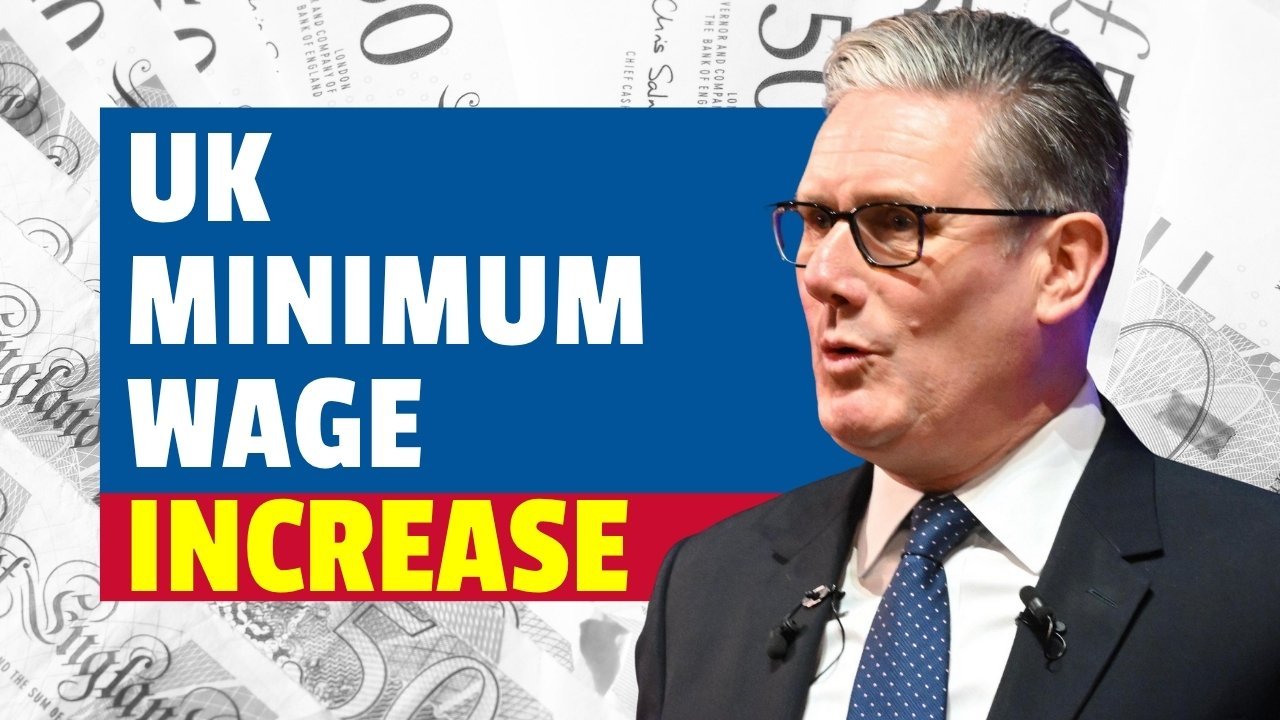The United Kingdom has confirmed a major increase to the National Minimum Wage (NMW) and National Living Wage (NLW) effective April 2025. The changes, based on recommendations from the Low Pay Commission, will affect more than 2.2 million workers, up from 1.9 million in 2024.
The new rates deliver some of the largest proportional rises in years, particularly for younger workers and apprentices. The National Living Wage for those aged 21 and over rises to £12.21 per hour, while 18–20 year olds will now earn £10.00. Workers aged 16–17 and apprentices also benefit from an uplift to £7.55. Government officials describe the move as an essential step in tackling wage inequality and preserving household incomes amid ongoing inflationary pressures.
Table of Contents
New Minimum Wage Rates from 2025
The wage reforms deliver significant increases across all categories, with younger workers and apprentices experiencing the steepest percentage gains.
| Worker Category | April 2024 Rate | April 2025 Rate | Increase (£) | Percentage Change |
|---|---|---|---|---|
| National Living Wage (21+) | £11.44 | £12.21 | +£0.77 | 6.7% |
| 18–20 Year Olds | £8.60 | £10.00 | +£1.40 | 16.3% |
| 16–17 Year Olds | £6.40 | £7.55 | +£1.15 | 18.0% |
| Apprentices | £6.40 | £7.55 | +£1.15 | 18.0% |
| Accommodation Offset | £9.99 | £10.66 | +£0.67 | 6.7% |
The highest proportional increases are directed at 16–20 year olds and apprentices, helping close historic pay gaps between younger employees and adults on the National Living Wage.
Why the Government Raised Wages
The decision to raise wages follows detailed analysis from the Low Pay Commission. Five key priorities guided the increase:
- Ensuring wages outpace inflation to protect real incomes.
- Reducing age-related pay disparities across the workforce.
- Expanding wage coverage to include 300,000 more jobs.
- Supporting household budgets and lowering reliance on Universal Credit.
- Balancing fairness for workers with employers’ ability to remain competitive.
Government officials argue that the move not only strengthens household earnings but also contributes to economic resilience by encouraging consumer spending.
Impact on Workers and Employers
For employees, the benefits are tangible. A full-time adult worker on the NLW will now earn about £23,800 annually, compared to £22,300 in 2024. An 18–20 year old working 37.5 hours per week will earn close to £19,500 per year, a rise of nearly £2,700 from last year. For apprentices, the uplift provides greater incentives to remain in vocational training.
Employers, meanwhile, face higher payroll costs. Labour-heavy sectors such as hospitality, retail, and care services are expected to feel the greatest impact. Some businesses may adjust prices or staffing levels to absorb costs. However, studies suggest wage increases can also improve staff retention, reduce recruitment expenses, and boost productivity, potentially offsetting some of the financial pressure.
Economic Implications
Economists forecast that the higher minimum wage will increase disposable income in low-income households, which typically spend a greater share of earnings on essential goods and services. This has the potential to stimulate consumer demand across the economy.
At the same time, risks remain if businesses pass wage costs to customers, which could contribute to inflation. The Low Pay Commission is monitoring these effects closely, particularly in sectors with narrow profit margins such as care services and small independent retailers.
Who Is Covered and Who Is Not
The NMW and NLW cover most categories of workers, but some groups are excluded from the system.
Covered Workers Include:
- Employees aged 16 and above, whether part-time or full-time.
- Agency staff, casual workers, and those on zero-hour contracts.
- Apprentices under qualifying contracts.
Exempt Groups Include:
- Self-employed individuals managing their own businesses.
- Volunteers and unpaid interns.
- Family members working unpaid in family-run businesses.
- Company directors without employment contracts.
This structure ensures the minimum wage targets formal employment arrangements without extending to non-standard roles.
Annual Comparison of Wage Levels
The table below shows how statutory wage levels have changed year on year, highlighting the steeper increases for younger workers in 2025.
| Year | NLW (21+) | 18–20 | 16–17 | Apprentice | Accommodation Offset |
|---|---|---|---|---|---|
| April 2024 | £11.44 | £8.60 | £6.40 | £6.40 | £9.99 |
| April 2025 | £12.21 | £10.00 | £7.55 | £7.55 | £10.66 |
While adult workers saw a 6.7% increase, younger groups benefitted from rises of up to 18%.
Challenges Ahead
Despite the benefits for workers, the new policy poses challenges. Smaller businesses, especially in rural areas or sectors with tight margins, may find it difficult to meet higher wage obligations. Regional variations in the cost of living also mean that while the increase is significant, it may still fall short of voluntary “real living wage” benchmarks in expensive cities such as London.
The government and the LPC will continue monitoring the policy’s medium-term effects, including employment levels, business viability, and regional inequalities. The long-term goal remains a sustainable balance between fair pay for employees and manageable costs for employers.
FAQs
What is the new National Living Wage for 2025?
From April 2025, the National Living Wage for workers aged 21 and over is £12.21 per hour, up from £11.44 in 2024.
How many workers are affected by the 2025 minimum wage increase?
The government estimates that around 2.2 million workers are now directly covered by the revised minimum wage structure, an increase from 1.9 million in 2024.
Which group received the highest pay increase?
The steepest rises went to 16–17 year olds and apprentices, whose hourly rate increased by 18% to £7.55.
Does the minimum wage apply to self-employed people?
No. The minimum wage does not apply to self-employed individuals, volunteers, unpaid family workers, or certain company directors without employment contracts.
What is the accommodation offset for 2025?
The accommodation offset, which applies when an employer provides housing, rises to £10.66 per day in 2025, up from £9.99 in 2024.




